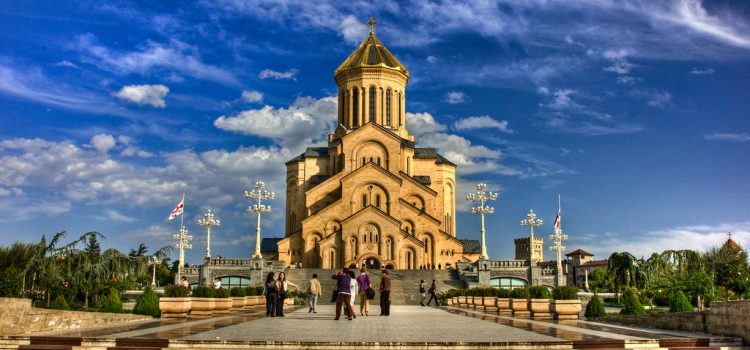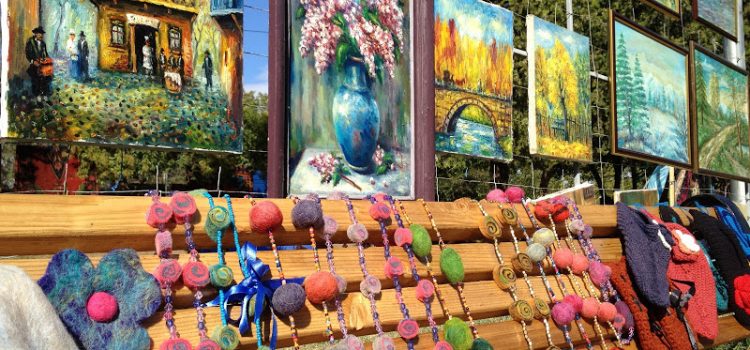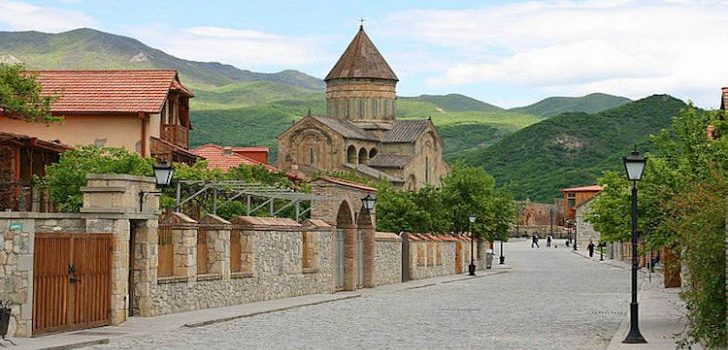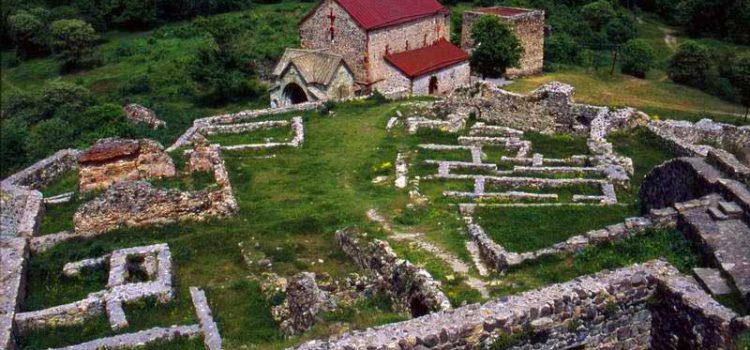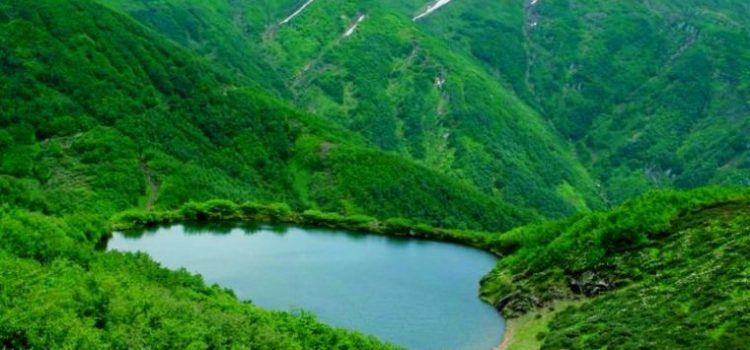Holy Trinity Cathedral of Tbilisi
The Holy Trinity Cathedral of Tbilisi commonly known as Sameba is the main cathedral of the Georgian orthodox church, located in Tbilisi, the capital of Georgia. Constructed between 1995 and 2004, it is the third tallest Eastern Orthodox cathedral in the world and one of the largest religious building in the world by total area. Sameba is a synthesis of traditional styles dominating the Georgian church architecture at various stages in history and has some Byzantine undertones.
The idea to build a new cathedral to commemorate 1,500 years of autocephaly of the Georgian Orthodox Church and 2,000 years from the birth of Jesus merged as early as 1989, a crucial year for the national awakening of the then Soviet republic of Georgia. In May 1989, the Georgian Orthodox Patriarchate and the authorities of Tbilisi announced an international contest for the “Holy Trinity Cathedral” project. No winner was chosen at the first round of the contest when more than a hundred projects were submitted. Finally the design by architect Archil Mindiashvili won. The subsequent turbulent years of civil unrest in Georgia deferred this grandiose plan for six years, and it was not until November 23, 1995, that the foundation of the new cathedral was laid.
The construction of the church was proclaimed as a “symbol of the Georgian national and spiritual revival” and was sponsored mostly by anonymous donations from several businessmen and common citizens. On November 23, 2004, on St. George’s Day, the cathedral was consecrated by Catholicos Patriarch of Georgia Ilia || and high-ranking representatives of fellow Orthodox Churches of the world. The ceremony was also attended by leaders of other religious and confessional communities in Georgia as well as by political leaders.
The Sameba Cathedral is erected on the Elia Hill, which rises above the left bank of the Mtkvari river in the historic neighborhood of Avlabari in Old Tbilisi.
Source: Wikipedia.com
Georgia must see place: David Aghmashenebeli Avenue
There are many must see places in Tbilisi, but now we want to speak about David Agmashenebeli Avenue
It’s one of the main avenues in the historical part of Tbilisi, known for its 19th-century classical architecture. The avenue is located on the left bank of the Mtkvari river, and runs from Saarcbruken, Square to Giorgi Tsabadze street. Currently named after David |V of Georgia, it was originally called Mikheil Street in 1851, and Plekhanov Street after the Russian revolutionary George Plekhanov, from 1918 to 1988.
Since 2010, the avenue has seen major rehabilitation works, which includes the renovation of seventy buildings, as well as the road, sidewalks and street lighting.
Agmashenebeli is easily accessible by metro at Marjanishvili metro, which is a single stop away from the city’s second historical artery – Rustaveli avenue.
Source: Georgia.travel
Photo: Tbilisi development fund
Narikala Fortess in old Tbilisi
Narikala fortess- also called the Mother Fortress of Tbilisi, Narikala is an ancient symbol of Tbilisi’s defence. The fortress was established in the 4th century, around the period when the city itself was founded. It was then known as Shuris-tsikhe (Invidious Fort). The name Narikala is said to derive from a Persian word for citadel, but another theory says was the name that Mongols used, meaning “little fortress”. It was expanded considerably by the Arabs during the 7th and 8th centuries. The Arabs built the Emir’s palace within its walls. King David further extended the Builder the fortress in th 11th century. Most of the existing fortifications date from the 16th and 17th centuries. In 1827 it was damaged by an earthquake and was not resorted. St. Nikolos church, inside the fortress walls, dates from the 12th century. It was renovated in 1996. Narikala offers you some of the best panoramas of the city.
We’d also advise you to take a walk along the Narikala Tourist route, a 1500 metre trail that runs from the top of the ridge near the Mother Georgia statue, around the fortress and down into Old Town to near the entrance to the Botanical Gardens. It offers stunning views at every turn and is a particular delight at night when the city lights shine below.
source: www.inyourpocket.com
First Georgian restaurant opened in Switzerland
Georgian food is popular. Not only in Georgia but also abroad. In many cities, there are a lot of Georgian restaurants. Take Cracow for example. According to Tripadviser there are five Georgian restaurants in the Polish city, in Berlin there are four. Thus, it might surprise you that in Switzerland, there have been none so far. Until three weeks ago Tereza Haveri opened her Georgian restaurant called Pré-Fleuri in the very heart of Lausanne on Lake Geneva.
expectations so far. People are coming for lunch and dinner, – says Haveri happily. Some guest drove as far as 200 kilometers just to dine at Pré-Fleuri. People are coming from all over Switzerland as there is no other Georgian restaurant in the country.
A mother’s dream is finally coming true
A Georgian restaurant was always my dream, – says Haveri. Or rather the dream of her late mother, who died a year ago and haven’t lived to see the opening. Haveri explains that her mother had always encouraged her in this project.
However, it wasn’t only her, but also her friends, who had motivated Haveri. Each time she invited them for dinner and cooked traditional Georgian dishes, they were thrilled with the food and told her to open a restaurant.
Tereza Haveri was born in Tbilisi, but 20 years ago, she and her Ezidi family had to leave the country due to their ethnicity. They had to start a new life in Central Europe. However, they took with them the Georgian cuisine. My mother taught me everything about it, – says Haveri. Thanks to her, but also to her brother and children, who help her run the restaurant, her dream is coming true.
Source: Georgianjournal.ge
Dry Bridge Flea Market – Best Place For Unique Souvenir Shopping In Tbilisi
Located in Tbilisi’s historic old town, 20 minutes walk from Freedom Square, Dry Market is the place, where you can buy literally every souvenir you ever dreamed of.
Even more, alongside traditional, typical tourist trinkets you can encounter old military medals from WWII, old enamel, Soviet kitsch, handmade jewelry (sometimes very eye-catching and exquisite pieces), vintage cameras and many other stuff without much fuss.
Here You can find original eastern European, Soviet, Georgian and even Armenian or Azerbaijani souvenirs.
Many pins and badges are waiting for you to choose and take home.
There are many oil paintings and watercolors, usually full of amazing, bright colors and cheerful spirit.
You may spend several hours just wandering and exploring from one to another, because you will never know, what another surprise is waiting for you at the next one.
You can see old Samovars, cameras, books, family photos, postcards, eyeglasses, playing cards and many other.
Also, there are sometimes absolutely unexpected things.
So, next time in Tbilisi, you know where to go for shopping
Source: Georgia.travel; Megapass
Taste Of Georgia: Ajara, Samegrelo, Svaneti
Going to Georgia, travelers usually prepare themselves to enjoy khachapuri, lobio, khinkali and, of course, a variety of meat barbecues, which are called “mtsvadi” in Georgian. Advanced experts in Georgian cuisine leave some free space in the stomach for pkhali, eggplants in walnut sauce, chakhokhbili and kharcho. However, our compact country has such a rich variety of regional dishes, that even if you decide to try one new for breakfast, lunch and dinner, you will need more than several weeks to explore the whole treasury.
Let’s take a little journey through the regions of Georgia and see what they can offer!
Starting with the West Coast… Well, Ajarian cuisine can really be described as “cheese rolling in butter”. Locals prepare very tasty and high-calorie meals. One of them is sinori, gentle rolls made of thin dough baked with matsoni/yoghurt and butter. Sinori can be eaten for breakfast – especially if you days is promising to be busy – or for a heavy family dinner.
Another calorie bomb from Ajara is called borano. It is made of Adjarian cheese melted in butter. Be prepared: it will be difficult to leave the table after you are finished!
Samegrelo, another Western Black Sea region of Georgia, is famous for the fact that its inhabitants prefer very spicy food. Megrelian adjika sauce is so sharp that Chuck Norris himself would probably cry, having tried it. If we talk about dishes, the most significant for the region are gebzhalia and elarji. Elarji is polenta brewed from corn flour with suluguni cheese inside. This heavy delicious dish should served hot!
Gebzhalia is a starter, delicate rolls with fresh cheese and mint in matsoni/yogurt sauce. It just melts inside your mouth, and is contrasting to those extremely spicy dishes and sauces that are served after.
From Samegrelo it is logical to climb higher into the mountains – to Upper Svaneti. This fabulously beautiful region with harsh living conditions is famous first of all for its special seasoning – Svan salt. Common salt is mixed with local spices in a special wooden mortar, and thus turns into slightly moist flavorful spice that can be used with salads, as well as with meat and fish.
Typical Svanetian pastry is kubdari, a tortilla stuffed with meat. In such difficult living conditions as there, meat filling is an excellent source of calories, and tortilla format is a convenient option for takeaway eating. The shepherds take kubdari as they travel to pastures, and eat them during a long time there.
Another traditional Svan pastry is chishdvari (down the mountains, in the rest of Georgia it is called “chvishtari”). It is made from corn flour, and keeps a piece of suluguni cheese inside. Chishdvari is especially tasty, as it’s taken just from a pan, and you eat it looking at the highest peaks of Georgia – let’s say, Shkhara – and breathe fresh air at an altitude of over 2,000 meters.
The first part of our culinary journey through the regions of Georgia is about to end now. Nevertheless, there is still a lot of interesting stuff for you! Stay tuned with Georgia and Travel!
Source: Georgia.travel
Heritage Sites
Heritage Site
Cave Towns Among the few notable cave towns in the world, the Georgian ones are of very special interest. Uplistsikhe, David Gareji monastery, and the world-famous cave town of Vardzia are nominated for the UNESCO World Heritage list. Uplistsikhe, ‘the fortress of the Lord’, can be dated back to the early Iron Age, and is located on a high rocky escarpment overlooking the bank of the Mtkvari River. Cut from natural sandy stone, the 8 hectares of cave-town have survived millions of people, erosion, aging and even earthquakes, but it still remains a good example of the mixture of pagan & Christian architecture. David Gareji monastery was founded in the 6th century on the slopes of the Gareji hills by one of the thirteen Syrian Fathers, Father David (Garejeli). Those fathers were missionaries from Mesopotamia promoting and spreading Christianity, the respected founders of many monasteries and holy places around Georgia. The frescoes here are superb. Some of them date as far back as the 9th and 10th centuries. The Golden Age of Georgia is directly reflected in the incredible 11th – 13th century frescoes. The incredible cave town of Vardzia dates back to Queen Tamar’s reign, nearly a thousand years ago. Her father, King George III started the foundation of the complex, while Queen Tamar continued its construction. Many frescoes date back to the beginning of the XII century. The complex itself consists of small chapels, bell towers, secret tunnels, monks’ caves as well as a fully functioning monastery to this day. Set in the most serene and stunning countryside, its beautiful location captures your imagination and brings you back to the era of Queen Tamar’s reign. Bagrati Cathedral and Gelati Monastery(UNESCO WEB) The construction of Bagrati Cathedral, named after Bagrat III, the first king of united Georgia, started at the end of the 10th century and was completed in the early years of the 11th century. Although partly destroyed by the Turks in 1691, its ruins still lie in the centre of Kutaisi. The Gelati Monastery, whose main buildings were erected between the 12th and 17th centuries, is a well-preserved complex, with wonderful mosaics and wall paintings. The cathedral and monastery represent the flowering of medieval architecture in Georgia. Historical Monuments of Mtskheta(UNESCO WEB) The historic churches of Mtskheta, former capital of Georgia, are outstanding examples of medieval religious architecture in the Caucasus. They show the high artistic and cultural level attained by this ancient kingdom. Upper Svaneti(UNESCO WEB) Preserved by its long isolation, the Upper Svaneti region of the Caucasus is an exceptional example of mountain scenery with medieval-type villages and tower-houses. The village of Chazhashi still has more than 200 of these very unusual houses, which were used both as dwellings and as defence posts against the invaders who plagued the region.
Meet your hominid ancestors in Georgia
Over 500 Paleolithic sites have been discovered in Georgia, which is considered a crossroad of cultures due to its location in the South Caucusus. Dmanisi, southeast of the capital Tbilisi, is considered one of the most significant sites.
“Exactly twenty five years ago we found a human jaw in Dmanisi – this was big sensation. It was impossible to imagine that you could have 1.8 million year-old fossils out of Africa. Since this discovery we have discovered another fossil. Now we have five skulls, four with jaws, different anatomical elements as well as animal bones and stone tools. Now, we could say that we have the best collection in the world of the early Homo out of Africa,” explains David Lordkipanidze, general director of the Georgian National Museum,
The Dmanisi skull is the most complete ancient hominid skull found to date. Known as Skull 5, it was discovered alongside the remains of four other early human ancestors, animal fossils and stone tools – all believed to be from the same time period – which makes the find truly unique.
“It’s the first evidence of humans moving out of Africa – very simple stone tools, brains literally a third of size of modern humans, but nonetheless they were able to exist in an environment with large saber-tooth cats and hyenas and other dangerous animals. It’s quite incredible,” says Nicholas Toth, co-director of the Stone Age Institute in Indiana.
The finding has forced scientists to rethink the story of early human evolution, as it could mean that rather than several Homo species, only a single-species – able to cope with a variety of ecosystems – emerged from the African continent.
‘Stone Age Georgia’ runs at the Georgian National Museum until September 2017.
Source: Euronews.com
Mtirala: Georgian nature at its purest
It is pure, unblemished nature…
Yet the Mtirala National Park can be found just 40 kilometres from Batumi, the capital city of Georgia’s autonomous republic of Adjara.
“We’re lucky to have the sunshine: this Adjarian national park, Mtirala, is considered Georgia’s rainiest spot of land,” said Euronews reporter Denis Loctier, as he explored the region.
In this high humidity, the air is fresh and fragrant with blooming flowers and herbs.
It’s a protected site for the region’s flora and fauna, including rare and endangered endemic species.
“Mtirala translates as ‘a weeping mountain’. This place is often clouded in mist and drizzle. That’s where the name comes from,” explained park guide, Zia Kontselidze.
At 1,500 metres above sea level, Mtirala’s trails are perfect for hiking, bird watching and adventure tours.
Source: Euronews.com
Vardzia: ‘The Cave Town’
It is called the cave town.
Vardzia is a spectacular site in southern Georgia, dug out of the Erusheti Mountain in 1185.
It had special significance for Georgians because it was associated with King Tamar – such a charismatic woman that she was crowned King instead of Queen!
“Among all the architectural jewels of Georgia, the Vardzia complex is the most precious,” said ‘Postcards’ reporter Claudio Rosmino.
“In this city, carved into the rock, there were houses, shops, libraries and even a water network. In total, 6,000 rooms, spread out over 13 levels”
In 1283, just a century after its construction, a devastating earthquake destroyed a huge part of the site. What we see today is less than a third of its original size.
“Vardzia cave complex was built for approximately 48 years by hand and was designed to host 50,000 people for defence purposes,” explained museum guide Tina Zedginidze.
“But later it became a Royal monastery with educational functions”
A small group of monks is still living there. Some 300 apartments can be visited and in some tunnels the old irrigation pipes still bring drinkable water.
Source: Euronews.com


